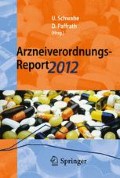Zusammenfassung
Für die Schmerzbehandlung werden in erster Linie Opioide und nichtopioide Analgetika eingesetzt. Die nichtopioiden Analgetika wirken zusätzlich antipyretisch, einige auch entzündungshemmend. In manchen Fällen bereitet es Schwierigkeiten, eine eindeutige Trennung von Analgetika gegenüber den Antirheumatika und Antiphlogistika vorzunehmen.
Access this chapter
Tax calculation will be finalised at checkout
Purchases are for personal use only
Preview
Unable to display preview. Download preview PDF.
Literatur
Allan L, Richarz U, Simpson K, Slappendel R (2005): Transdermal fentanyl versus sustai- ned release oral morphine in strong-opioid naive patients with chronic low back pain. Spine 30: 2484-2490.
Arzneimittelkommission der deutschen Ärzteschaft (1986): Bundesgesundheitsamt schränkt Anwendungsgebiet von Metamizol-haltigen Monopräparaten ein. Dtsch Ärztebl 83: 3267.
Arzneimittelkommission der deutschen Ärzteschaft (2007a): Empfehlungen zur Therapie von Tumorschmerzen. AVP-Sonderheft Therapieempfehlungen, 3. Auflage. Internet: www.akdae.de/35/10/66-Tumorschmerzen-2007-3Auflage.pdf
Arzneimittelkommission der deutschen Ärzteschaft (2007b): Leberschäden unter Flupirtin. Dtsch Ärztebl 104: A3200.
Budd K (1990): Experience with partial antagonists in the treatment of cancer pain. In: Doyle D (Ed). Opioids in the treatment of cancer pain. Royal Society of Medicine, International Congress and Symposium Series No. 146, pp. 51-54.
Dahan A, Yassen A, Bijl H, Romberg R, Sarton E, Teppema L, Olofsen E, Danhof M (2005): Comparison of the respiratory effects of intravenous buprenorphine and fentanyl in humans and rats. Br J Anaesth 94: 825-834.
Devulder J (2010): Flupirtine in pain management: pharmacological properties and clini- cal use. CNS Drugs 24: 867-881.
Drover DR, Angst MS, Valle M, Ramaswamy B, Naidu S, Stanski DR, Verotta D (2002): Input characteristics and bioavailability after administration of immediate and a new extended-release formulation of hydromorphone in healthy volunteers. Anesthesiology 97: 827-836.
Frampton JE (2010): Tapentadol immediate release: a review of its use in the treatment of moderate to severe acute pain. Drugs 70: 1719-1743.
Furlan AD, Sandoval JA, Mailis-Gagnon A, Tunks E (2006): Opioids for chronic non- cancer pain: a meta-analysis of effectiveness and side effects. CMAJ 174: 1589-1594.
Hanks GW, De Conno F, Cherny N et al (Expert Working Group of the Research Network of the European Association for Palliative Care) (2001): Morphine and alternative opi- oids in cancer pain: the EAPC recommendations. Br J Cancer 84: 587-593.
Jacox A, Carr DB, Payne R et al (Agency for Health Care Policy and Research (AHCPR) Pharmacological Management) (1994): Recommendations. In: Management of can- 6 cer pain. Clinical Practice Guideline No 9. U.S. Department of Health and Human Services, Public Health Service, AHCPR Publication No 94-0592, March, Rockville.
Meissner W, Leyendecker P, Mueller-Lissner S, Nadstawek J, Hopp M, Ruckes C, Wirz S, Fleischer W, Reimer K (2009a): A randomised controlled trial with prolonged-release oral oxycodone and naloxone to prevent and reverse opioid-induced constipation. Eur J Pain 13: 56-64.
Meissner W, Mueller-Lissner S, Nadstawek J, Hopp M, Ruckes C, Wirz S, Fleischer W, Reimer K, Leyendecker P (2009b): Dr. Meissner and colleagues reply to the Letter to the Editor from Andrew Wilcock entitled 'Prolonged-release naloxone can cause systemic opioid withdrawal'. Eur J Pain 13: 1002-1003.
Radbruch L, Elsner F (2005): Palliative Schmerztherapie, Cannabinoide. Internist 46: 1105-1114.
Ripamonti C, Fagnoni E, Campa T, Brunelli C, De Conno F (2006): Is the use of transdermal fentanyl inappropriate according to the WHO guidelines and the EAPC recom- mendations? A study of cancer patients in Italy. Support Care Cancer 14: 400-407.
Quigley C (2002): Hydromorphone for acute and chronic pain. Cochrane Database Syst Rev. 2002 (1): CD003447.
The Pain Society (2004): Recommendations for the appropriate use of opioids for persistent non-cancer pain. A consensus statement prepared on behalf of the Pain Society, the Royal College of Anaesthetists, the Royal College of General Practitioners and the Royal College of Psychiatrists. March 2004. Internet: www.britishpainsociety.org/pdf/ opioids_doc_2004.pdf
Wilcock A (2009): Prolonged-release naloxone can cause systemic opioid withdrawal. Eur J Pain 13: 1001 (2009).
World Health Organization (WHO) (1986): Cancer Pain Relief1. World Health Organization Publications, Geneva, Switzerland.
World Health Organization (WHO) (1996): Cancer pain relief, 2nd edn. World Health Organization Publications, Geneva, Switzerland.
Zhang WY, Po AL (1996): Analgesic efficacy of paracetamol and its combination with codeine and caffeine in surgical pain - a metaanalysis. J Clin Pharm Ther 21: 261-282.
Zhang WY, Po AL (1997): Do codeine and caffeine enhance the analgesic effect of aspirin? A systematic overview. J Clin Pharm Ther 22: 79-97.
Author information
Authors and Affiliations
Rights and permissions
Copyright information
© 2012 Springer Medizin Verlag Berlin, Heidelberg
About this chapter
Cite this chapter
Böger, R., Schmidt, G. (2012). Analgetika. In: Arzneiverordnungs-Report 2012. Springer, Berlin, Heidelberg. https://doi.org/10.1007/978-3-642-29242-2_6
Download citation
DOI: https://doi.org/10.1007/978-3-642-29242-2_6
Publisher Name: Springer, Berlin, Heidelberg
Print ISBN: 978-3-642-29241-5
Online ISBN: 978-3-642-29242-2
eBook Packages: Medicine (German Language)

